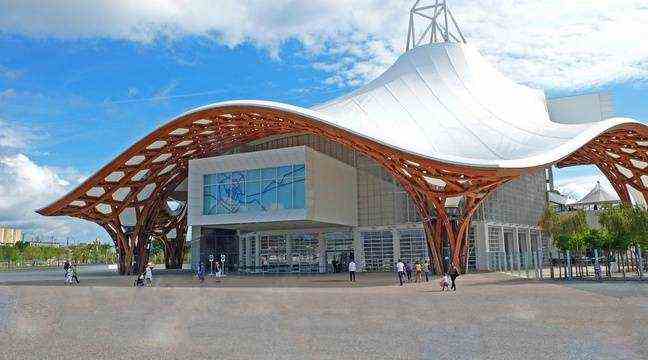The Pompidou-Metz center. – Wikicommons
- The Center Pompidou in Metz pays tribute to Giuseppe Arcimboldo in its new exhibition “Face à Arcimboldo”, open to the public from May 29 to November 22, 2021.
- Through an original route imagined by Chiara Parisi, director of the Center, visitors will be able to discover unpublished creations by the Milanese painter such as the famous painting “Printemps” but also works by artists ranging from the 16th to the 21st century, recalling the world of ‘Arcimboldo.
- On the occasion of the exhibition opening weekend, May 29 and 30, the Center Pompidou in Metz will be offering a series of unique artistic events as part of the Renaissance program.
Peonies, wild roses, daisies, cabbage, squash, strawberries … If at first glance, one can believe in the description of a still life, it suffices to move away a few meters from this composition plant so that the feminine face of the Spring, famous painting by Giuseppe Arcimboldo. From May 29 to November 22, 2021, visitors to the Center Pompidou in Metz will be able to try this trompe-l’oeil experience on the occasion of “Face à Arcimboldo”: a unique exhibition showcasing the little-known works of the Italian painter from the Renaissance and its artistic impact.
Venetian inspiration
To reflect the multiple talents of the Lombard master, made famous by his Seasons – these famous heads made up of fruits, vegetables, flowers and other plants – Chiara Parisi, director of the Center Pompidou Metz since December 2019, imagined an astonishing tribute. In line with The Arcimboldo Effect. The transformations of the face in the 16th century and the 20th century, first exhibition dedicated to the artist carried out by Pontus Hultén at Palazzo Grassi in Venice in 1987, Arcimboldo’s work is put into perspective with the works of more than 130 artists from Antiquity to the present day.
“When I was in college in Rome, I visited the Pontus Hultén exhibition in 87. I believe that it has, in a way, determined the work that I do today,” reveals Chiara Parisi. Indispensable, therefore, for the director of the Center not to include at the heart of her first programming since her appointment ” Homage to Arcimboldo, Cono and the Chagny table ” by Mario Merz. VSCommissioned by Pontus Hultén from Mario Merz for his exhibition in Venice, this three-part installation has been recomposed for the first time since 1987, especially for “Face à Arcimboldo”.
Rethinking the classic exhibition
In a very neutral scenography, designed with gray concrete blocks, no chronological mark, nor thematic grouping. Like a common thread, only Arcimboldo makes the link between the surrealism of Salvador Dalí, the cubism of Picasso or the pop art of Roy Lichtenstein. Visitors are then invited to walk according to their curiosity and to the rhythm of the works, eras and genres that collide. If this very free wandering can be disturbing for some, Anne Horvath, curator of the exhibition nevertheless justifies this choice: “This course leads us towards the creations which give us the most envy. We get lost in the exhibition, we no longer know whether we are in the 16th or 21st century, who is the author… This creates a direct and real relationship with the works ”.
A contemporary reception
Studied from school and admired by the greatest artists from the 16th century to the present day, Arcimboldo has irrigated the history of art with his works for more than five centuries. This influence, Anne Horvath, explains it by the universality of Arcimboldo: “In his works, we observe both a playful side, with objects of everyday life that speak to a young audience but we mainly decipher messages. hidden and paradoxes between the human being and the animal, the vegetable and the mineral or the monstrous and the marvelous. So many questions that have inspired, indirectly or not, many artists over the years. “
| PRESS |
Today we presented a preview of the exhibition “Face à Arcimboldo” to all the press before the opening to the public on Saturday, May 29th. #metz #faceaarcimboldo #centrepompidoumetz #pressday pic.twitter.com/TEcNgyf081– Center Pompidou-Metz (@PompidouMetz) May 27, 2021
“Facing Arcimboldo” is also an opportunity to appreciate the Italian artist in new facets. “It would be a shame to sum it up to the four seasons,” says Anne Horvath. We then learn that Arcimboldo was an official painter at the Habsburg court, conductor, advisor of the imperial collections responsible for supplying the cabinets of curiosities of the emperors of the time or even an inventor. “He would have created the ocular harpsichord, unfortunately we have to date no trace of this work”, deplores Anne Horvath. In the course of a sketch, we also discover unpublished works by the artist such as stained glass, from the Duomo in Milan.
To celebrate the opening weekend of the “Face à Arcimboldo” exhibition and the return of the public, this Saturday 29 and Sunday 30 May, the Center Pompidou Metz will be offering a series of events new and free artistic works as part of the Renaissance program.

